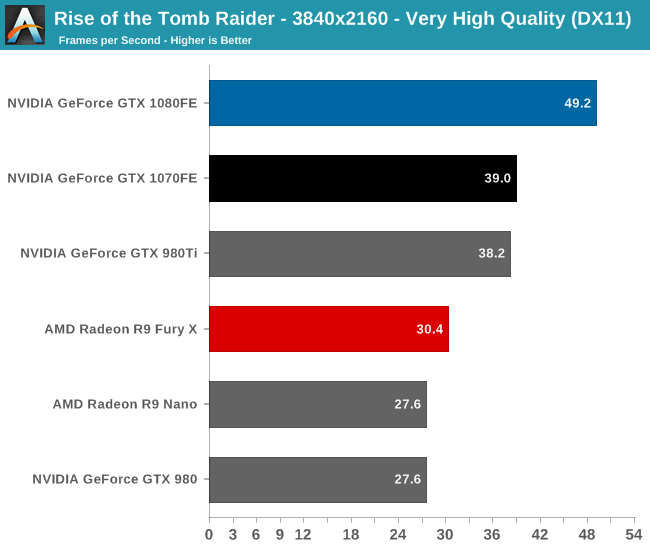The NVIDIA GeForce GTX 1080 & GTX 1070 Founders Editions Review: Kicking Off the FinFET Generation
by Ryan Smith on July 20, 2016 8:45 AM ESTRise of the Tomb Raider
Starting things off in our benchmark suite is the built-in benchmark for Rise of the Tomb Raider, the latest iteration in the long-running action-adventure gaming series. One of the unique aspects of this benchmark is that it’s actually the average of 4 sub-benchmarks that fly through different environments, which keeps the benchmark from being too weighted towards a GPU’s performance characteristics under any one scene.



To kick things off then, while I picked the benchmark order before collecting the performance results, it’s neat that Rise of the Tomb Raider ends up being a fairly consistent representation of how the various video cards compare to each other. The end result, as you might expect, puts the GTX 1080 and GTX 1070 solidly in the lead. And truthfully there’s no reason for it to be anything but this; NVIDIA does not face any competition from AMD at the high-end at this point, so the two GP104 cards are going to be unrivaled. It’s not a question of who wins, but by how much.
Overall we find the GTX 1080 ahead of its predecessor, the GTX 980, by anywhere between 60% and 78%, with the lead increasing with the resolution. The GTX 1070’s lead isn’t quite as significant though, ranging from 53% to 60#. This is consistent with the fact that the GTX 1070 is specified to trail the GTX 1080 by more than we saw with the 980/970 in 2014, which means that in general the GTX 1070 won’t see quite as much uplift.
What we do get however is confirmation that the GTX 1070FE is a GTX 980 Ti and more. The performance of what was NVIDIA’s $650 flagship can now be had in a card that costs $450, and with any luck will get cheaper still as supplies improve. For 1440p gamers this should hit a good spot in terms of performance.
Otherwise when it comes to 4K gaming, NVIDIA has made a lot of progress thanks to GTX 1080, but even their latest and greatest card isn’t quite going to crack 60fps here. We haven’t yet escaped having to made quality tradeoffs for 4K at this time, and it’s likely that future games will drive that point home even more.
Finally, 1080p is admittedly here largely for the sake of including much older cards like the GTX 680, to show what kind of progress NVIDIA has made since their first 28nm high-end card. The result? A 4.25x performance increase over the GTX 680.










200 Comments
View All Comments
Ryan Smith - Wednesday, July 20, 2016 - link
The prices listed are based on checking Newegg daily for the past week. The sub-$429 cards have never been in stock when I've checked.powerarmour - Wednesday, July 20, 2016 - link
Lulz how late?jabbadap - Wednesday, July 20, 2016 - link
Great thorough review.You have a funny typo on the fast sync page:
" Fast Sync doesn’t replace either Adaptive Sync or G-Sync"
I think you meant Adaptive Vsync, not that VESA standard which nvidia does not support.
Ryan Smith - Wednesday, July 20, 2016 - link
Right you are. Thanks!bill44 - Wednesday, July 20, 2016 - link
Where can I find a FULL review please?Thanks
Ryan Smith - Wednesday, July 20, 2016 - link
"Where can I find a FULL review please?"This article was an excerpt of the full review. The complete, 5 volume set on GTX 1080 will be available at your local book store in October. ;-)
catavalon21 - Wednesday, July 20, 2016 - link
AwesomeAndrewJacksonZA - Thursday, July 21, 2016 - link
Cool! Thanks Ryan! Did you reach your stretch goals on your Kickstarter campaign so that you can afford the scanning electron microscope for great photos?bill44 - Thursday, July 21, 2016 - link
Thanks Ryan.I was on about audio. Not for games, but for my music playback (SACD, DVDA) with different sampling rates that includes 88.2 and 176.4Khz. I can't find FULL specifications for the 100 series GTX cards that include this information, or any decoding capabilities. I was looking for the GTX 1060 for HTPC use with madVR.
Where can I find out about audio and sampling rates? MadVR capabilities?
Ryan Smith - Friday, July 22, 2016 - link
As far as I know, audio capabilities are the same as on the 900 series. Unfortunately I don't have more detail than that right now.